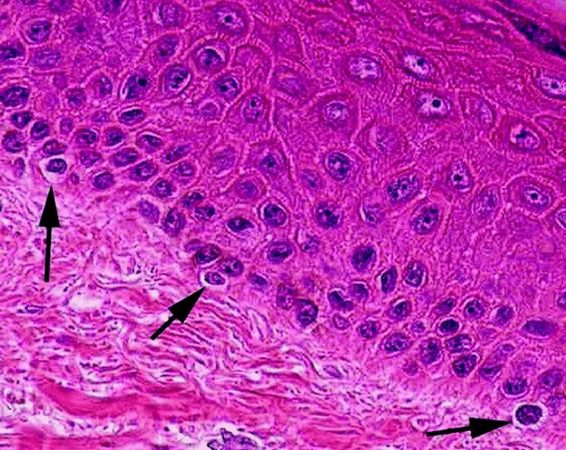
Studying the complex genetics behind hair colour reveals how melanin affects us
by Frida Lona Durazo, Postdoctoral fellow, Computational Genetics, Université de Montréal
Even though some genes are known to determine hair colour variation, recent studies based on large cohorts of people from the United Kingdom and Latin America have shown that there are more than a dozen genes involved in hair colour.

Melanocytes produce melanin, which in turn affects skin and hair colour. (Setijanti H.B., Rusmawati E., Fitria R., Erlina T., Adriany R., Murtiningsih), CC BY
One of the traits that we usually use to physically describe people is their hair colour. Hair is a useful descriptor because it varies so much among us.
Melanin is the molecule responsible for the many different hair colour tones. It’s also responsible for the colour of our skin and eyes. We inherit these traits from our parents in a complex way.
Understanding how our genetic information can produce different hair colour tones can be as difficult as untangling long hair after not brushing it for several days.
Even though some genes are known to determine hair colour variation, recent studies based on large cohorts of people from the United Kingdom and Latin America have shown that there are more than a dozen genes involved in hair colour.
In a recent paper published in Communications Biology, my colleagues and I studied the genes involved in hair colour in a Canadian cohort of nearly 13,000 individuals of European-related ancestry. Our findings provide insights about genetic variants that may be driving differences in hair colour.
Types of melanin
Melanin is produced in a specific cell-type called melanocytes found in skin, eyes and hair follicles. Melanin is also found in the brain. The type and amount of melanin and how it is distributed in cells is what creates differences in hair, skin and eye colour.
Melanoma, a kind of skin cancer, consists of an overgrowth of melanocytes in the skin.
There are two main types of melanin in our hair: eumelanin and pheomelanin. Eumelanin is also known as the brown-black pigment, whereas pheomelanin is known as the red-orange pigment. People with red hair have much more pheomelanin, people with dark hair have higher levels of eumelanin than pheomelanin, and blonde hair is due to low amounts of both pigments.
The main difference that guides which of the two types of melanin is synthesized is a switch in a protein called the melanocyte-stimulating hormone receptor, or MC1R.
Variants of the gene MC1R that lead to a loss of function of the protein can affect the production of pheomelanin. In contrast, there are many genes across our genome involved eumelanin variation, including less damaging genetic variants in the same MC1R gene.
Untangling genetic complexity
In our study, we used genome-wide association studies (GWAS, pronounced ghee-was) to identify genetic regions associated with hair colour across our autosomal chromosomes. GWAS identifies overlapping associations in a gene of interest or other functional genomic elements. This method also identifies associations in intergenic regions, the DNA sequences located between genes.
Correlation does not imply causation. Therefore, we also worked on obtaining evidence to locate genetic variants within or near genes of interest that are more likely to be causing hair colour variation. This helps us better understand the molecular mechanisms involved in pigmentation.
We identified genetic variants that have been previously reported, such as those damaging the function of MC1R, which can result in less eumelanin production or even switch the production to pheomelanin. Other genetic variants identified that are involved in hair colour and pigmentation in general, do not change the protein’s structure or function. Instead, they regulate the expression of the gene, which means that they control how much of a protein is produced.
One example is a genetic variant near the gene OCA2, in which the gene expression of OCA2 decreases in the presence of guanine, one of the building blocks of DNA. This results in lower melanin production.
We also tested if the associated regions shared genetic signals with DNA methylation — which can regulate gene expression — in melanocytes. We observed that the DNA methylation state may be a relevant process in regulating pigmentation in some genomic regions. Future investigation is needed to provide concrete evidence on this.
Pigmentation pathways
By studying the genetic factors determining hair colour, we can increase our understanding of how pigmentation occurs. This helps us further understand pigmentation diseases and their genetic risk factors, such as the role of pigmentation in cutaneous melanoma and in vitiligo.
Another interesting application is the improvement of prediction models of hair colour from a DNA source, which has implications for forensic DNA phenotyping in police investigations, which predicts what someone looks like from forensic samples.
Including other population groups in the research of hair colour may help us identify new genes, which can further improve our understanding of pigmentation mechanisms.
This article is republished from The Conversation under a Creative Commons license. Read the original article.